International Human Resources: Compensation and Benefits Report
VerifiedAdded on 2021/06/08
|14
|3096
|246
Report
AI Summary
This report provides a comprehensive overview of international compensation and benefits within the context of international human resource management. It begins with an introduction to globalization and its impact on IHRM, emphasizing the need for organizations to adapt and expand internationally. The literature review explores the objectives of international compensation packages, the main elements of an international compensation plan (including base salary, allowances, and benefits), and different compensation approaches, such as the balance sheet and going rate approaches. The report then presents a case study of Johnson & Johnson, examining its international compensation policies and how they align with the company's overall strategy and employee needs. The analysis highlights J&J's use of a mix of compensation approaches, its focus on employee well-being, and the comprehensive benefits it offers to its international employees. The report concludes by summarizing the key findings and implications for managing international compensation effectively.
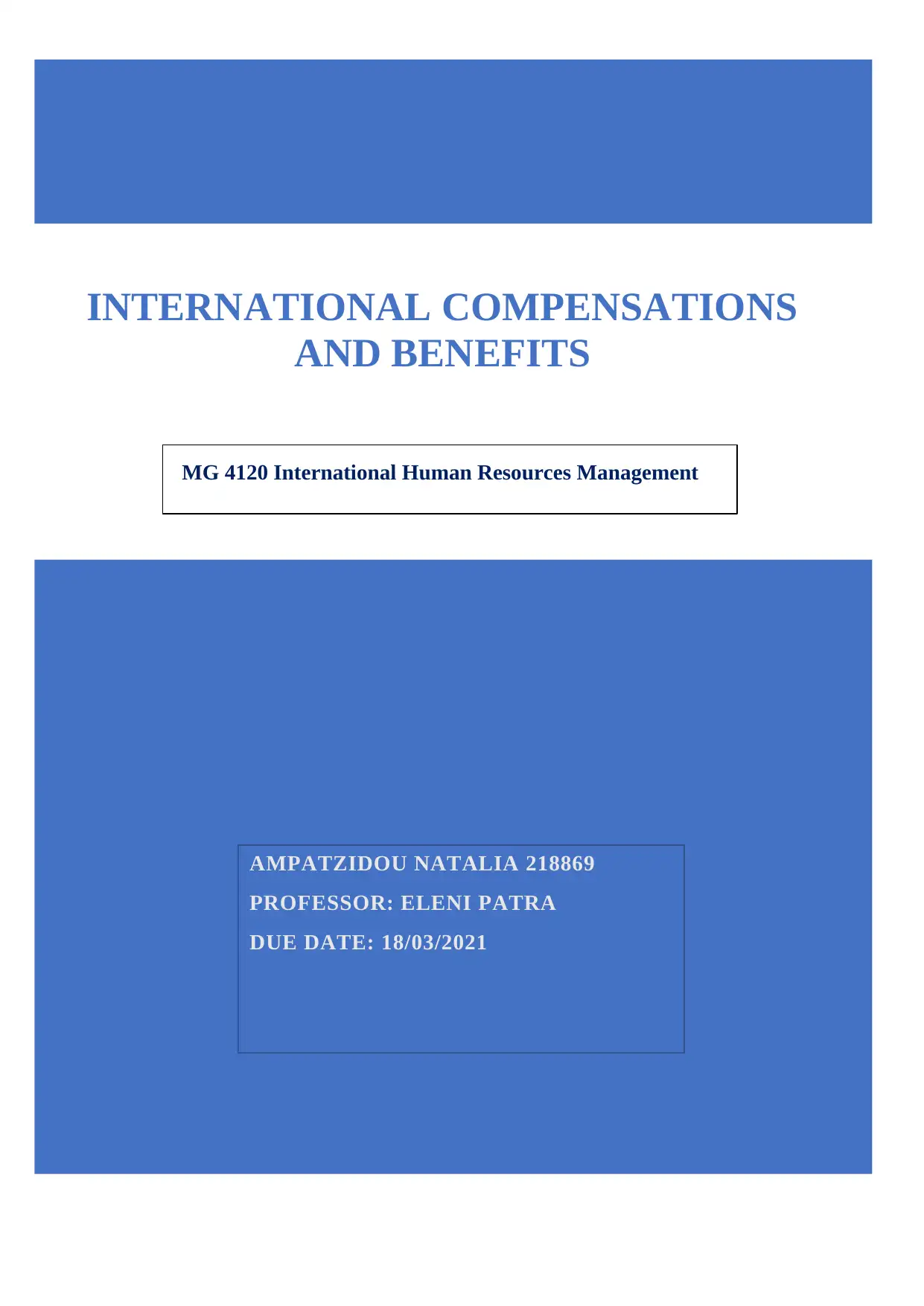
INTERNATIONAL COMPENSATIONS
AND BENEFITS
AMPATZIDOU NATALIA 218869
PROFESSOR: ELENI PATRA
DUE DATE: 18/03/2021
MG 4120 International Human Resources Management
AND BENEFITS
AMPATZIDOU NATALIA 218869
PROFESSOR: ELENI PATRA
DUE DATE: 18/03/2021
MG 4120 International Human Resources Management
Paraphrase This Document
Need a fresh take? Get an instant paraphrase of this document with our AI Paraphraser
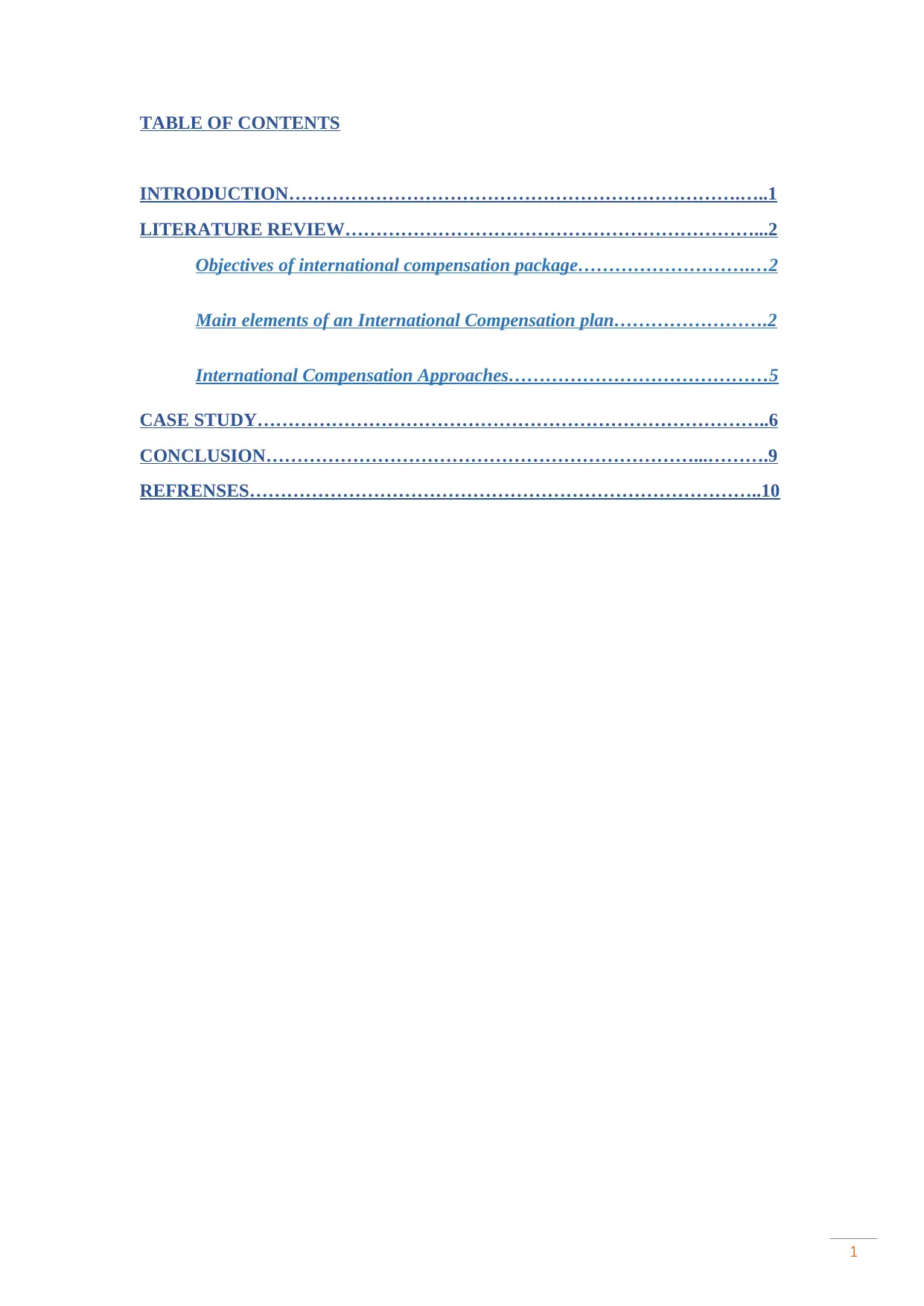
1
TABLE OF CONTENTS
INTRODUCTION……………………………………………………………….…..1
LITERATURE REVIEW…………………………………………………………...2
Objectives of international compensation package……………………….…2
Main elements of an International Compensation plan…………………….2
International Compensation Approaches……………………………………5
CASE STUDY………………………………………………………………………..6
CONCLUSION……………………………………………………………...……….9
REFRENSES………………………………………………………………………..10
TABLE OF CONTENTS
INTRODUCTION……………………………………………………………….…..1
LITERATURE REVIEW…………………………………………………………...2
Objectives of international compensation package……………………….…2
Main elements of an International Compensation plan…………………….2
International Compensation Approaches……………………………………5
CASE STUDY………………………………………………………………………..6
CONCLUSION……………………………………………………………...……….9
REFRENSES………………………………………………………………………..10
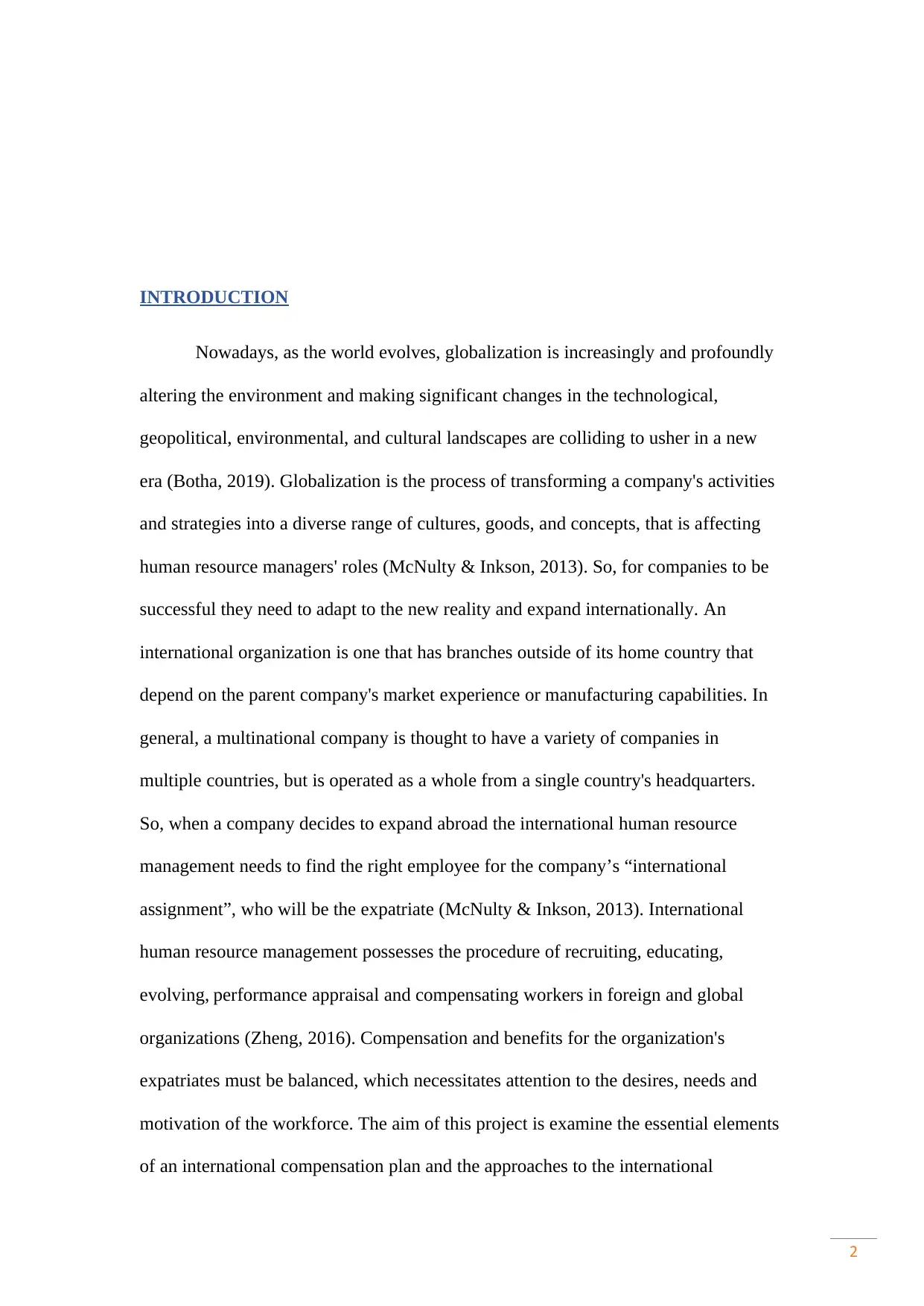
2
INTRODUCTION
Nowadays, as the world evolves, globalization is increasingly and profoundly
altering the environment and making significant changes in the technological,
geopolitical, environmental, and cultural landscapes are colliding to usher in a new
era (Botha, 2019). Globalization is the process of transforming a company's activities
and strategies into a diverse range of cultures, goods, and concepts, that is affecting
human resource managers' roles (McNulty & Inkson, 2013). So, for companies to be
successful they need to adapt to the new reality and expand internationally. An
international organization is one that has branches outside of its home country that
depend on the parent company's market experience or manufacturing capabilities. In
general, a multinational company is thought to have a variety of companies in
multiple countries, but is operated as a whole from a single country's headquarters.
So, when a company decides to expand abroad the international human resource
management needs to find the right employee for the company’s “international
assignment”, who will be the expatriate (McNulty & Inkson, 2013). International
human resource management possesses the procedure of recruiting, educating,
evolving, performance appraisal and compensating workers in foreign and global
organizations (Zheng, 2016). Compensation and benefits for the organization's
expatriates must be balanced, which necessitates attention to the desires, needs and
motivation of the workforce. The aim of this project is examine the essential elements
of an international compensation plan and the approaches to the international
INTRODUCTION
Nowadays, as the world evolves, globalization is increasingly and profoundly
altering the environment and making significant changes in the technological,
geopolitical, environmental, and cultural landscapes are colliding to usher in a new
era (Botha, 2019). Globalization is the process of transforming a company's activities
and strategies into a diverse range of cultures, goods, and concepts, that is affecting
human resource managers' roles (McNulty & Inkson, 2013). So, for companies to be
successful they need to adapt to the new reality and expand internationally. An
international organization is one that has branches outside of its home country that
depend on the parent company's market experience or manufacturing capabilities. In
general, a multinational company is thought to have a variety of companies in
multiple countries, but is operated as a whole from a single country's headquarters.
So, when a company decides to expand abroad the international human resource
management needs to find the right employee for the company’s “international
assignment”, who will be the expatriate (McNulty & Inkson, 2013). International
human resource management possesses the procedure of recruiting, educating,
evolving, performance appraisal and compensating workers in foreign and global
organizations (Zheng, 2016). Compensation and benefits for the organization's
expatriates must be balanced, which necessitates attention to the desires, needs and
motivation of the workforce. The aim of this project is examine the essential elements
of an international compensation plan and the approaches to the international
⊘ This is a preview!⊘
Do you want full access?
Subscribe today to unlock all pages.

Trusted by 1+ million students worldwide
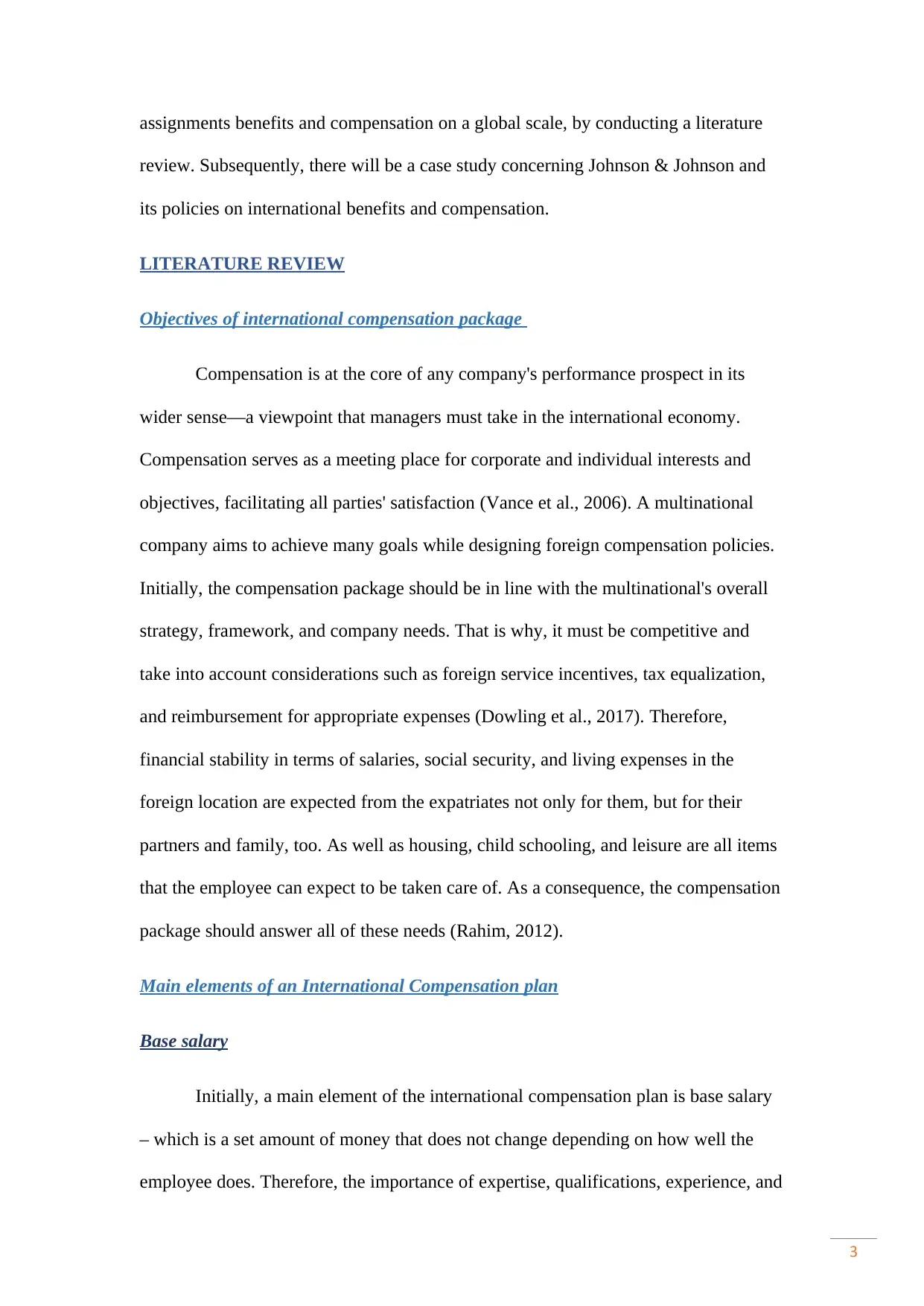
3
assignments benefits and compensation on a global scale, by conducting a literature
review. Subsequently, there will be a case study concerning Johnson & Johnson and
its policies on international benefits and compensation.
LITERATURE REVIEW
Objectives of international compensation package
Compensation is at the core of any company's performance prospect in its
wider sense—a viewpoint that managers must take in the international economy.
Compensation serves as a meeting place for corporate and individual interests and
objectives, facilitating all parties' satisfaction (Vance et al., 2006). A multinational
company aims to achieve many goals while designing foreign compensation policies.
Initially, the compensation package should be in line with the multinational's overall
strategy, framework, and company needs. That is why, it must be competitive and
take into account considerations such as foreign service incentives, tax equalization,
and reimbursement for appropriate expenses (Dowling et al., 2017). Therefore,
financial stability in terms of salaries, social security, and living expenses in the
foreign location are expected from the expatriates not only for them, but for their
partners and family, too. As well as housing, child schooling, and leisure are all items
that the employee can expect to be taken care of. As a consequence, the compensation
package should answer all of these needs (Rahim, 2012).
Main elements of an International Compensation plan
Base salary
Initially, a main element of the international compensation plan is base salary
– which is a set amount of money that does not change depending on how well the
employee does. Therefore, the importance of expertise, qualifications, experience, and
assignments benefits and compensation on a global scale, by conducting a literature
review. Subsequently, there will be a case study concerning Johnson & Johnson and
its policies on international benefits and compensation.
LITERATURE REVIEW
Objectives of international compensation package
Compensation is at the core of any company's performance prospect in its
wider sense—a viewpoint that managers must take in the international economy.
Compensation serves as a meeting place for corporate and individual interests and
objectives, facilitating all parties' satisfaction (Vance et al., 2006). A multinational
company aims to achieve many goals while designing foreign compensation policies.
Initially, the compensation package should be in line with the multinational's overall
strategy, framework, and company needs. That is why, it must be competitive and
take into account considerations such as foreign service incentives, tax equalization,
and reimbursement for appropriate expenses (Dowling et al., 2017). Therefore,
financial stability in terms of salaries, social security, and living expenses in the
foreign location are expected from the expatriates not only for them, but for their
partners and family, too. As well as housing, child schooling, and leisure are all items
that the employee can expect to be taken care of. As a consequence, the compensation
package should answer all of these needs (Rahim, 2012).
Main elements of an International Compensation plan
Base salary
Initially, a main element of the international compensation plan is base salary
– which is a set amount of money that does not change depending on how well the
employee does. Therefore, the importance of expertise, qualifications, experience, and
Paraphrase This Document
Need a fresh take? Get an instant paraphrase of this document with our AI Paraphraser
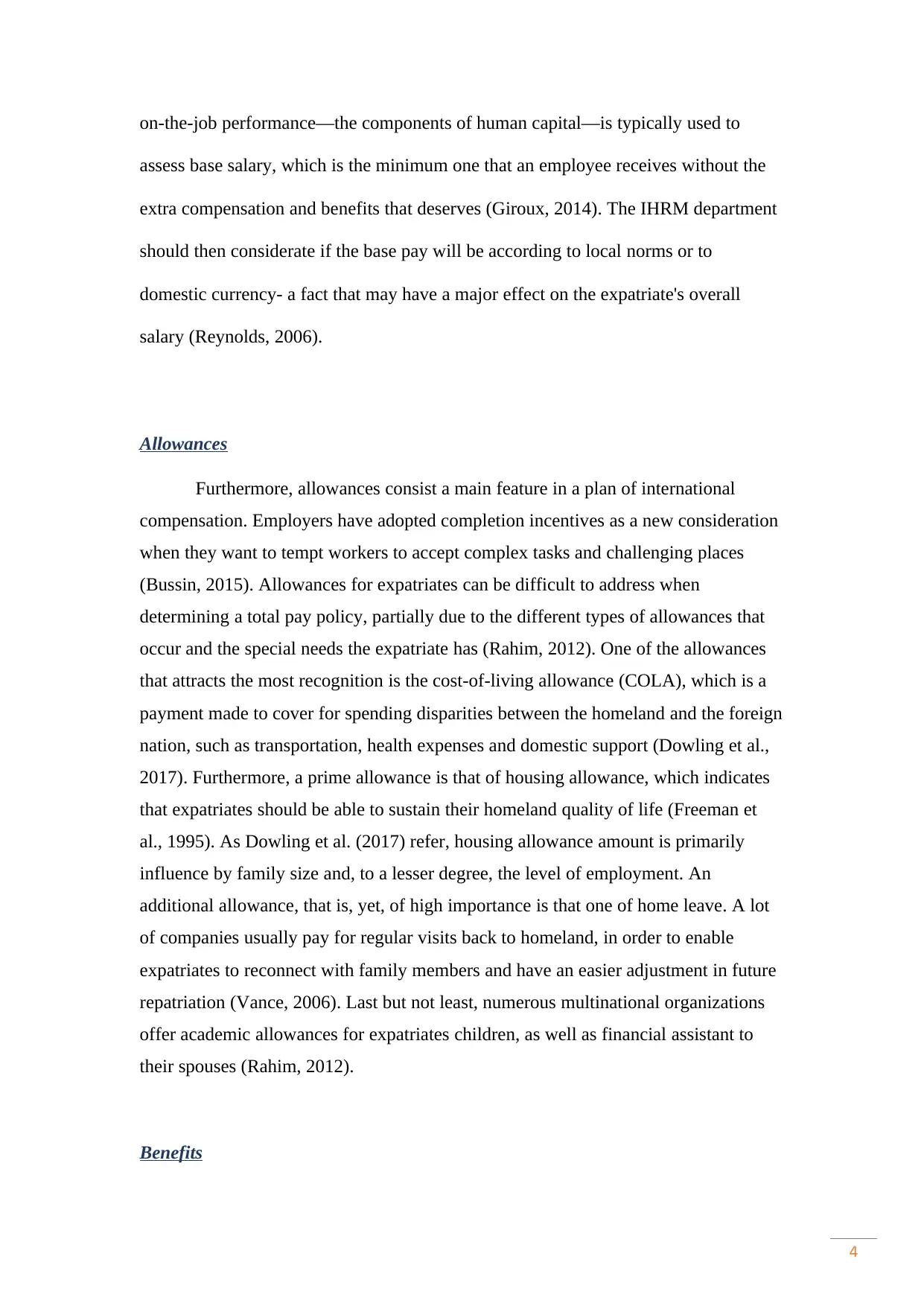
4
on-the-job performance—the components of human capital—is typically used to
assess base salary, which is the minimum one that an employee receives without the
extra compensation and benefits that deserves (Giroux, 2014). The IHRM department
should then considerate if the base pay will be according to local norms or to
domestic currency- a fact that may have a major effect on the expatriate's overall
salary (Reynolds, 2006).
Allowances
Furthermore, allowances consist a main feature in a plan of international
compensation. Employers have adopted completion incentives as a new consideration
when they want to tempt workers to accept complex tasks and challenging places
(Bussin, 2015). Allowances for expatriates can be difficult to address when
determining a total pay policy, partially due to the different types of allowances that
occur and the special needs the expatriate has (Rahim, 2012). One of the allowances
that attracts the most recognition is the cost-of-living allowance (COLA), which is a
payment made to cover for spending disparities between the homeland and the foreign
nation, such as transportation, health expenses and domestic support (Dowling et al.,
2017). Furthermore, a prime allowance is that of housing allowance, which indicates
that expatriates should be able to sustain their homeland quality of life (Freeman et
al., 1995). As Dowling et al. (2017) refer, housing allowance amount is primarily
influence by family size and, to a lesser degree, the level of employment. An
additional allowance, that is, yet, of high importance is that one of home leave. A lot
of companies usually pay for regular visits back to homeland, in order to enable
expatriates to reconnect with family members and have an easier adjustment in future
repatriation (Vance, 2006). Last but not least, numerous multinational organizations
offer academic allowances for expatriates children, as well as financial assistant to
their spouses (Rahim, 2012).
Benefits
on-the-job performance—the components of human capital—is typically used to
assess base salary, which is the minimum one that an employee receives without the
extra compensation and benefits that deserves (Giroux, 2014). The IHRM department
should then considerate if the base pay will be according to local norms or to
domestic currency- a fact that may have a major effect on the expatriate's overall
salary (Reynolds, 2006).
Allowances
Furthermore, allowances consist a main feature in a plan of international
compensation. Employers have adopted completion incentives as a new consideration
when they want to tempt workers to accept complex tasks and challenging places
(Bussin, 2015). Allowances for expatriates can be difficult to address when
determining a total pay policy, partially due to the different types of allowances that
occur and the special needs the expatriate has (Rahim, 2012). One of the allowances
that attracts the most recognition is the cost-of-living allowance (COLA), which is a
payment made to cover for spending disparities between the homeland and the foreign
nation, such as transportation, health expenses and domestic support (Dowling et al.,
2017). Furthermore, a prime allowance is that of housing allowance, which indicates
that expatriates should be able to sustain their homeland quality of life (Freeman et
al., 1995). As Dowling et al. (2017) refer, housing allowance amount is primarily
influence by family size and, to a lesser degree, the level of employment. An
additional allowance, that is, yet, of high importance is that one of home leave. A lot
of companies usually pay for regular visits back to homeland, in order to enable
expatriates to reconnect with family members and have an easier adjustment in future
repatriation (Vance, 2006). Last but not least, numerous multinational organizations
offer academic allowances for expatriates children, as well as financial assistant to
their spouses (Rahim, 2012).
Benefits
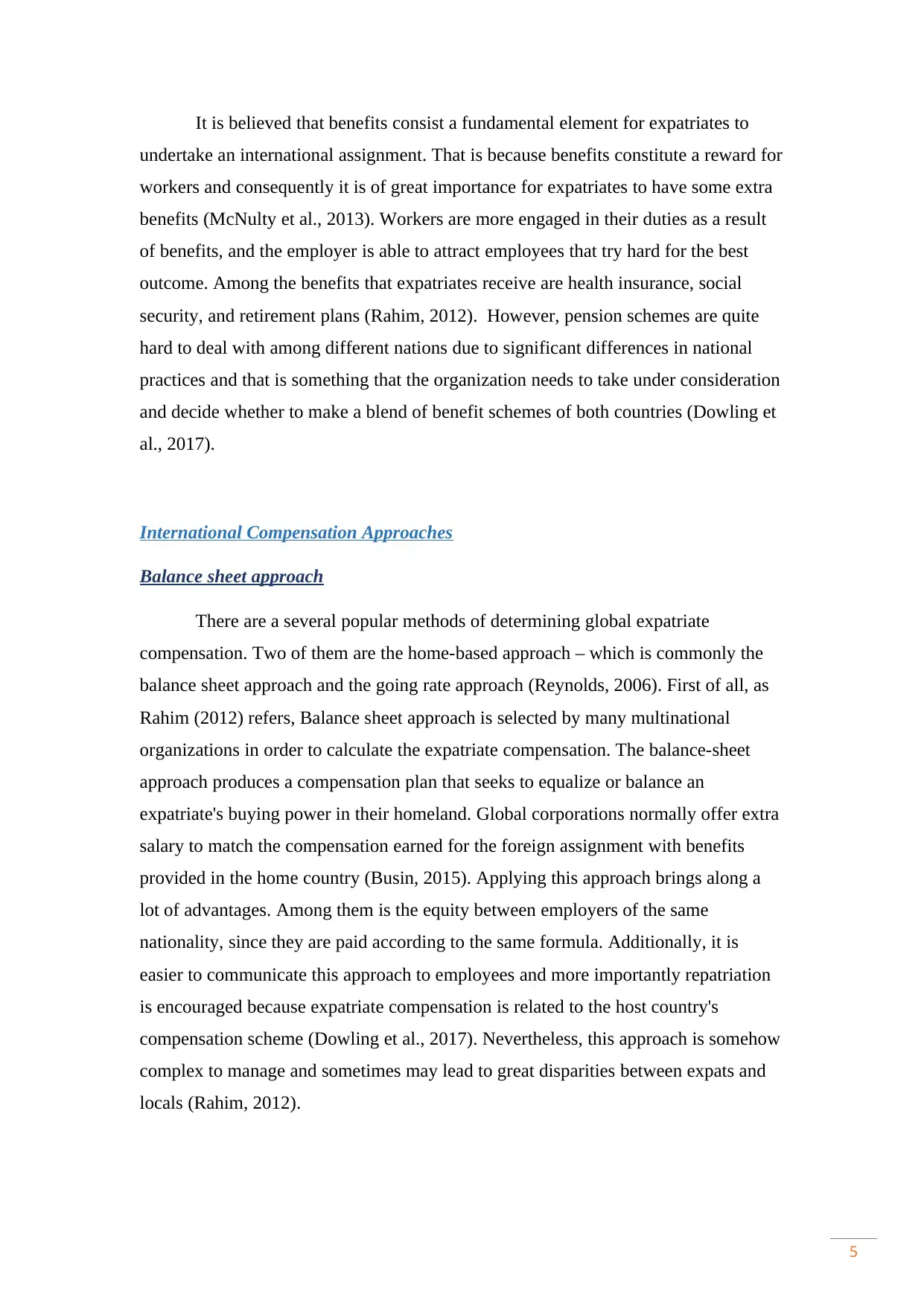
5
It is believed that benefits consist a fundamental element for expatriates to
undertake an international assignment. That is because benefits constitute a reward for
workers and consequently it is of great importance for expatriates to have some extra
benefits (McNulty et al., 2013). Workers are more engaged in their duties as a result
of benefits, and the employer is able to attract employees that try hard for the best
outcome. Among the benefits that expatriates receive are health insurance, social
security, and retirement plans (Rahim, 2012). However, pension schemes are quite
hard to deal with among different nations due to significant differences in national
practices and that is something that the organization needs to take under consideration
and decide whether to make a blend of benefit schemes of both countries (Dowling et
al., 2017).
International Compensation Approaches
Balance sheet approach
There are a several popular methods of determining global expatriate
compensation. Two of them are the home-based approach – which is commonly the
balance sheet approach and the going rate approach (Reynolds, 2006). First of all, as
Rahim (2012) refers, Balance sheet approach is selected by many multinational
organizations in order to calculate the expatriate compensation. The balance-sheet
approach produces a compensation plan that seeks to equalize or balance an
expatriate's buying power in their homeland. Global corporations normally offer extra
salary to match the compensation earned for the foreign assignment with benefits
provided in the home country (Busin, 2015). Applying this approach brings along a
lot of advantages. Among them is the equity between employers of the same
nationality, since they are paid according to the same formula. Additionally, it is
easier to communicate this approach to employees and more importantly repatriation
is encouraged because expatriate compensation is related to the host country's
compensation scheme (Dowling et al., 2017). Nevertheless, this approach is somehow
complex to manage and sometimes may lead to great disparities between expats and
locals (Rahim, 2012).
It is believed that benefits consist a fundamental element for expatriates to
undertake an international assignment. That is because benefits constitute a reward for
workers and consequently it is of great importance for expatriates to have some extra
benefits (McNulty et al., 2013). Workers are more engaged in their duties as a result
of benefits, and the employer is able to attract employees that try hard for the best
outcome. Among the benefits that expatriates receive are health insurance, social
security, and retirement plans (Rahim, 2012). However, pension schemes are quite
hard to deal with among different nations due to significant differences in national
practices and that is something that the organization needs to take under consideration
and decide whether to make a blend of benefit schemes of both countries (Dowling et
al., 2017).
International Compensation Approaches
Balance sheet approach
There are a several popular methods of determining global expatriate
compensation. Two of them are the home-based approach – which is commonly the
balance sheet approach and the going rate approach (Reynolds, 2006). First of all, as
Rahim (2012) refers, Balance sheet approach is selected by many multinational
organizations in order to calculate the expatriate compensation. The balance-sheet
approach produces a compensation plan that seeks to equalize or balance an
expatriate's buying power in their homeland. Global corporations normally offer extra
salary to match the compensation earned for the foreign assignment with benefits
provided in the home country (Busin, 2015). Applying this approach brings along a
lot of advantages. Among them is the equity between employers of the same
nationality, since they are paid according to the same formula. Additionally, it is
easier to communicate this approach to employees and more importantly repatriation
is encouraged because expatriate compensation is related to the host country's
compensation scheme (Dowling et al., 2017). Nevertheless, this approach is somehow
complex to manage and sometimes may lead to great disparities between expats and
locals (Rahim, 2012).
⊘ This is a preview!⊘
Do you want full access?
Subscribe today to unlock all pages.

Trusted by 1+ million students worldwide
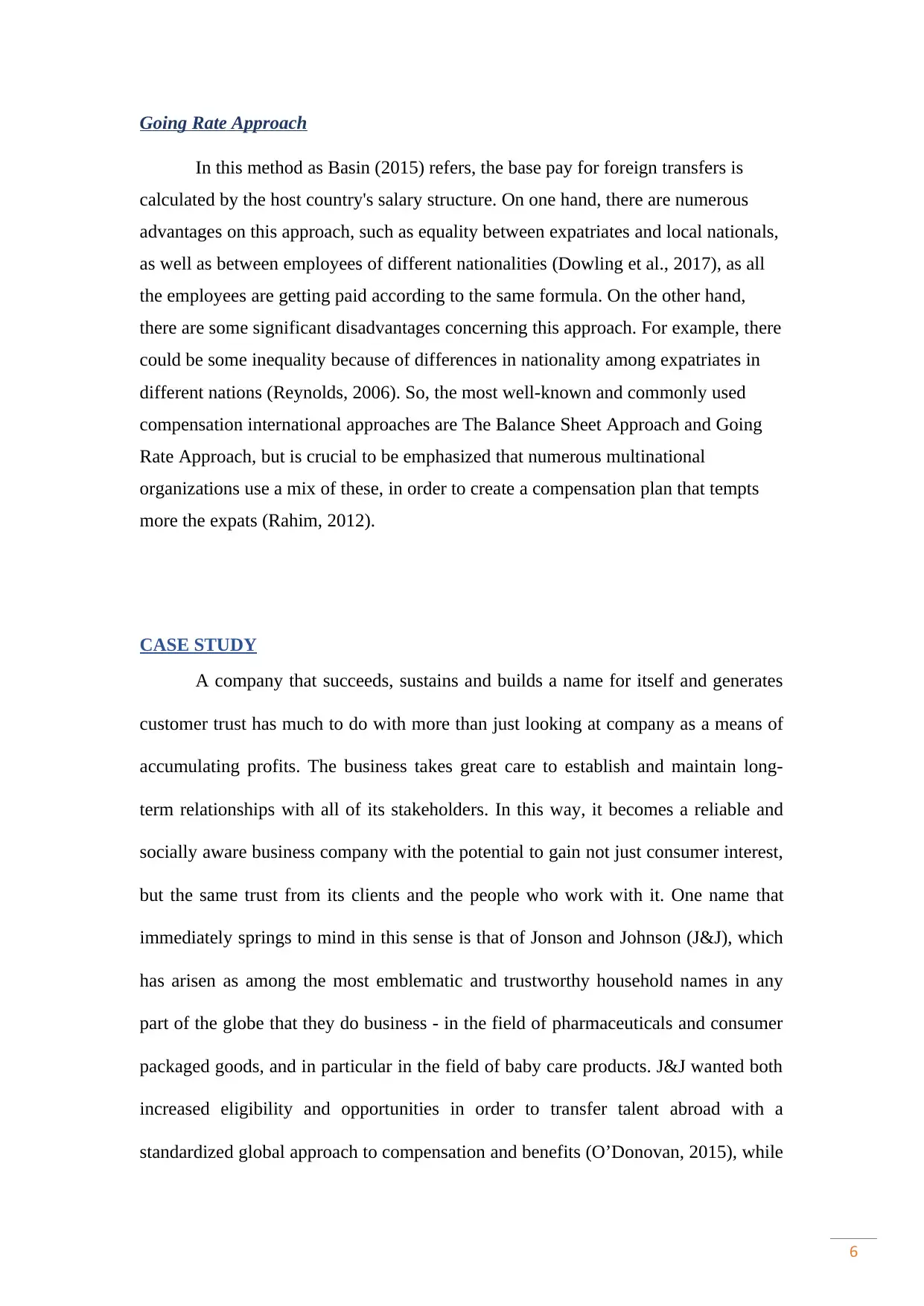
6
Going Rate Approach
In this method as Basin (2015) refers, the base pay for foreign transfers is
calculated by the host country's salary structure. On one hand, there are numerous
advantages on this approach, such as equality between expatriates and local nationals,
as well as between employees of different nationalities (Dowling et al., 2017), as all
the employees are getting paid according to the same formula. On the other hand,
there are some significant disadvantages concerning this approach. For example, there
could be some inequality because of differences in nationality among expatriates in
different nations (Reynolds, 2006). So, the most well-known and commonly used
compensation international approaches are The Balance Sheet Approach and Going
Rate Approach, but is crucial to be emphasized that numerous multinational
organizations use a mix of these, in order to create a compensation plan that tempts
more the expats (Rahim, 2012).
CASE STUDY
A company that succeeds, sustains and builds a name for itself and generates
customer trust has much to do with more than just looking at company as a means of
accumulating profits. The business takes great care to establish and maintain long-
term relationships with all of its stakeholders. In this way, it becomes a reliable and
socially aware business company with the potential to gain not just consumer interest,
but the same trust from its clients and the people who work with it. One name that
immediately springs to mind in this sense is that of Jonson and Johnson (J&J), which
has arisen as among the most emblematic and trustworthy household names in any
part of the globe that they do business - in the field of pharmaceuticals and consumer
packaged goods, and in particular in the field of baby care products. J&J wanted both
increased eligibility and opportunities in order to transfer talent abroad with a
standardized global approach to compensation and benefits (O’Donovan, 2015), while
Going Rate Approach
In this method as Basin (2015) refers, the base pay for foreign transfers is
calculated by the host country's salary structure. On one hand, there are numerous
advantages on this approach, such as equality between expatriates and local nationals,
as well as between employees of different nationalities (Dowling et al., 2017), as all
the employees are getting paid according to the same formula. On the other hand,
there are some significant disadvantages concerning this approach. For example, there
could be some inequality because of differences in nationality among expatriates in
different nations (Reynolds, 2006). So, the most well-known and commonly used
compensation international approaches are The Balance Sheet Approach and Going
Rate Approach, but is crucial to be emphasized that numerous multinational
organizations use a mix of these, in order to create a compensation plan that tempts
more the expats (Rahim, 2012).
CASE STUDY
A company that succeeds, sustains and builds a name for itself and generates
customer trust has much to do with more than just looking at company as a means of
accumulating profits. The business takes great care to establish and maintain long-
term relationships with all of its stakeholders. In this way, it becomes a reliable and
socially aware business company with the potential to gain not just consumer interest,
but the same trust from its clients and the people who work with it. One name that
immediately springs to mind in this sense is that of Jonson and Johnson (J&J), which
has arisen as among the most emblematic and trustworthy household names in any
part of the globe that they do business - in the field of pharmaceuticals and consumer
packaged goods, and in particular in the field of baby care products. J&J wanted both
increased eligibility and opportunities in order to transfer talent abroad with a
standardized global approach to compensation and benefits (O’Donovan, 2015), while
Paraphrase This Document
Need a fresh take? Get an instant paraphrase of this document with our AI Paraphraser
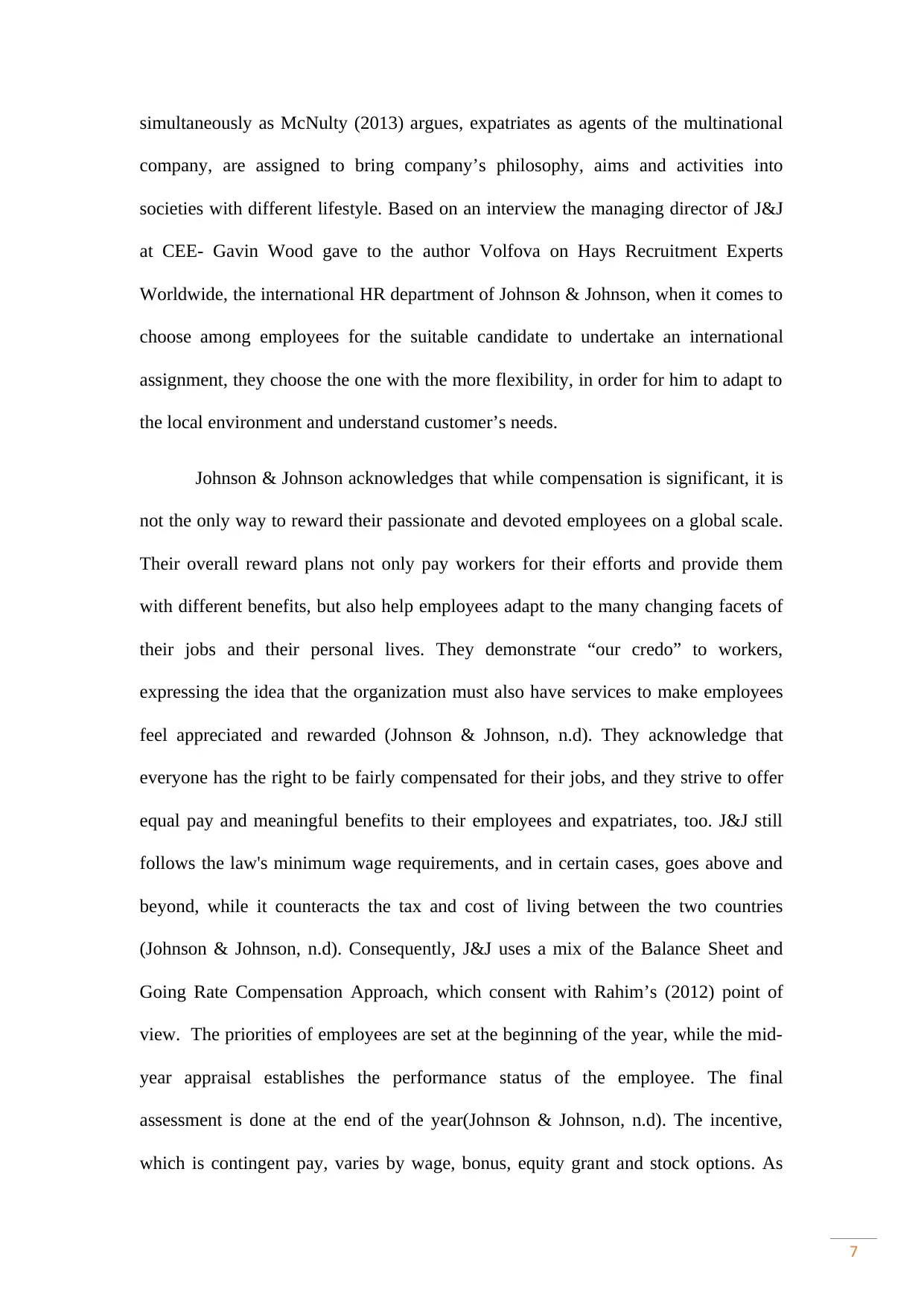
7
simultaneously as McNulty (2013) argues, expatriates as agents of the multinational
company, are assigned to bring company’s philosophy, aims and activities into
societies with different lifestyle. Based on an interview the managing director of J&J
at CEE- Gavin Wood gave to the author Volfova on Hays Recruitment Experts
Worldwide, the international HR department of Johnson & Johnson, when it comes to
choose among employees for the suitable candidate to undertake an international
assignment, they choose the one with the more flexibility, in order for him to adapt to
the local environment and understand customer’s needs.
Johnson & Johnson acknowledges that while compensation is significant, it is
not the only way to reward their passionate and devoted employees on a global scale.
Their overall reward plans not only pay workers for their efforts and provide them
with different benefits, but also help employees adapt to the many changing facets of
their jobs and their personal lives. They demonstrate “our credo” to workers,
expressing the idea that the organization must also have services to make employees
feel appreciated and rewarded (Johnson & Johnson, n.d). They acknowledge that
everyone has the right to be fairly compensated for their jobs, and they strive to offer
equal pay and meaningful benefits to their employees and expatriates, too. J&J still
follows the law's minimum wage requirements, and in certain cases, goes above and
beyond, while it counteracts the tax and cost of living between the two countries
(Johnson & Johnson, n.d). Consequently, J&J uses a mix of the Balance Sheet and
Going Rate Compensation Approach, which consent with Rahim’s (2012) point of
view. The priorities of employees are set at the beginning of the year, while the mid-
year appraisal establishes the performance status of the employee. The final
assessment is done at the end of the year(Johnson & Johnson, n.d). The incentive,
which is contingent pay, varies by wage, bonus, equity grant and stock options. As
simultaneously as McNulty (2013) argues, expatriates as agents of the multinational
company, are assigned to bring company’s philosophy, aims and activities into
societies with different lifestyle. Based on an interview the managing director of J&J
at CEE- Gavin Wood gave to the author Volfova on Hays Recruitment Experts
Worldwide, the international HR department of Johnson & Johnson, when it comes to
choose among employees for the suitable candidate to undertake an international
assignment, they choose the one with the more flexibility, in order for him to adapt to
the local environment and understand customer’s needs.
Johnson & Johnson acknowledges that while compensation is significant, it is
not the only way to reward their passionate and devoted employees on a global scale.
Their overall reward plans not only pay workers for their efforts and provide them
with different benefits, but also help employees adapt to the many changing facets of
their jobs and their personal lives. They demonstrate “our credo” to workers,
expressing the idea that the organization must also have services to make employees
feel appreciated and rewarded (Johnson & Johnson, n.d). They acknowledge that
everyone has the right to be fairly compensated for their jobs, and they strive to offer
equal pay and meaningful benefits to their employees and expatriates, too. J&J still
follows the law's minimum wage requirements, and in certain cases, goes above and
beyond, while it counteracts the tax and cost of living between the two countries
(Johnson & Johnson, n.d). Consequently, J&J uses a mix of the Balance Sheet and
Going Rate Compensation Approach, which consent with Rahim’s (2012) point of
view. The priorities of employees are set at the beginning of the year, while the mid-
year appraisal establishes the performance status of the employee. The final
assessment is done at the end of the year(Johnson & Johnson, n.d). The incentive,
which is contingent pay, varies by wage, bonus, equity grant and stock options. As
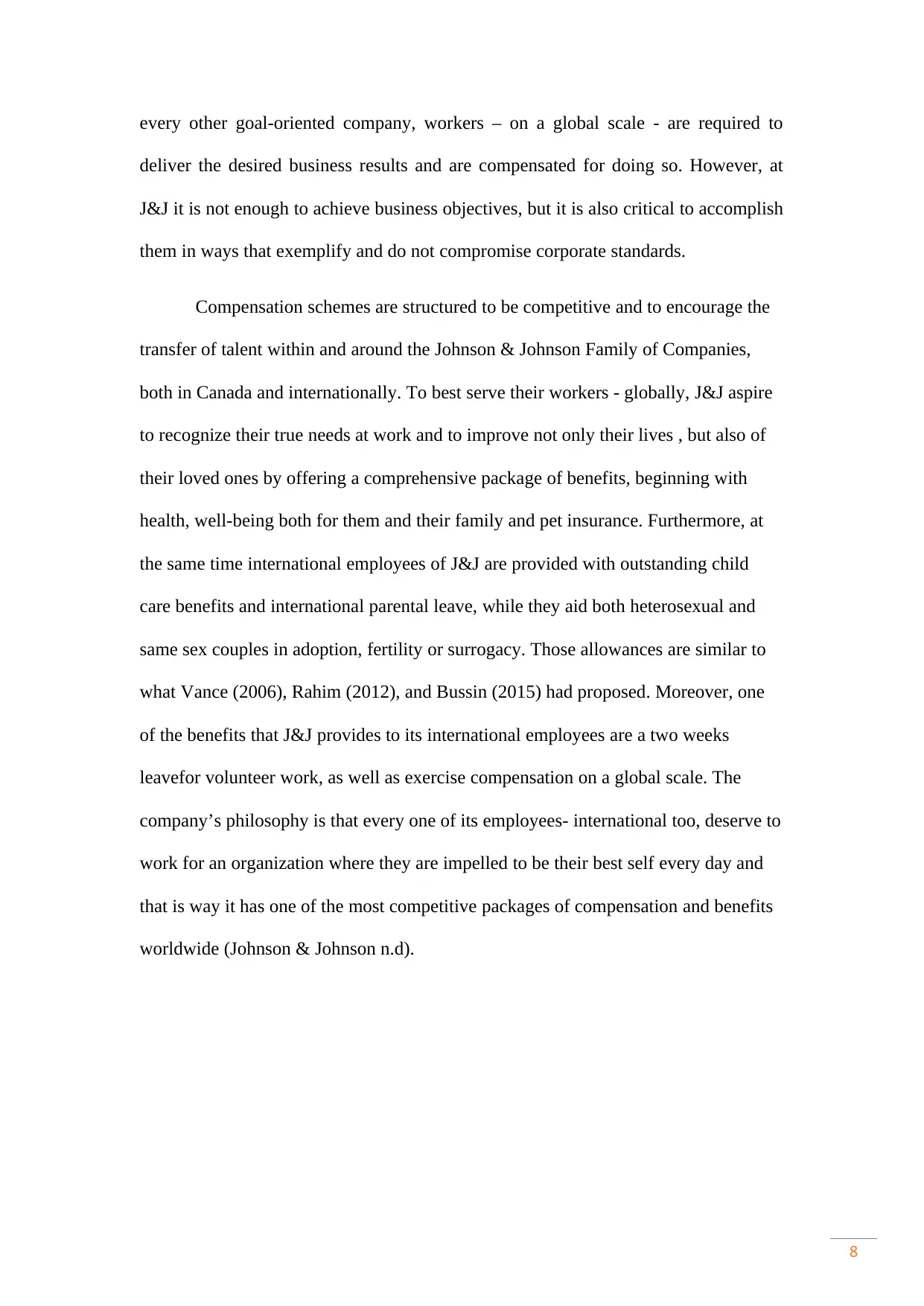
8
every other goal-oriented company, workers – on a global scale - are required to
deliver the desired business results and are compensated for doing so. However, at
J&J it is not enough to achieve business objectives, but it is also critical to accomplish
them in ways that exemplify and do not compromise corporate standards.
Compensation schemes are structured to be competitive and to encourage the
transfer of talent within and around the Johnson & Johnson Family of Companies,
both in Canada and internationally. To best serve their workers - globally, J&J aspire
to recognize their true needs at work and to improve not only their lives , but also of
their loved ones by offering a comprehensive package of benefits, beginning with
health, well-being both for them and their family and pet insurance. Furthermore, at
the same time international employees of J&J are provided with outstanding child
care benefits and international parental leave, while they aid both heterosexual and
same sex couples in adoption, fertility or surrogacy. Those allowances are similar to
what Vance (2006), Rahim (2012), and Bussin (2015) had proposed. Moreover, one
of the benefits that J&J provides to its international employees are a two weeks
leavefor volunteer work, as well as exercise compensation on a global scale. The
company’s philosophy is that every one of its employees- international too, deserve to
work for an organization where they are impelled to be their best self every day and
that is way it has one of the most competitive packages of compensation and benefits
worldwide (Johnson & Johnson n.d).
every other goal-oriented company, workers – on a global scale - are required to
deliver the desired business results and are compensated for doing so. However, at
J&J it is not enough to achieve business objectives, but it is also critical to accomplish
them in ways that exemplify and do not compromise corporate standards.
Compensation schemes are structured to be competitive and to encourage the
transfer of talent within and around the Johnson & Johnson Family of Companies,
both in Canada and internationally. To best serve their workers - globally, J&J aspire
to recognize their true needs at work and to improve not only their lives , but also of
their loved ones by offering a comprehensive package of benefits, beginning with
health, well-being both for them and their family and pet insurance. Furthermore, at
the same time international employees of J&J are provided with outstanding child
care benefits and international parental leave, while they aid both heterosexual and
same sex couples in adoption, fertility or surrogacy. Those allowances are similar to
what Vance (2006), Rahim (2012), and Bussin (2015) had proposed. Moreover, one
of the benefits that J&J provides to its international employees are a two weeks
leavefor volunteer work, as well as exercise compensation on a global scale. The
company’s philosophy is that every one of its employees- international too, deserve to
work for an organization where they are impelled to be their best self every day and
that is way it has one of the most competitive packages of compensation and benefits
worldwide (Johnson & Johnson n.d).
⊘ This is a preview!⊘
Do you want full access?
Subscribe today to unlock all pages.

Trusted by 1+ million students worldwide
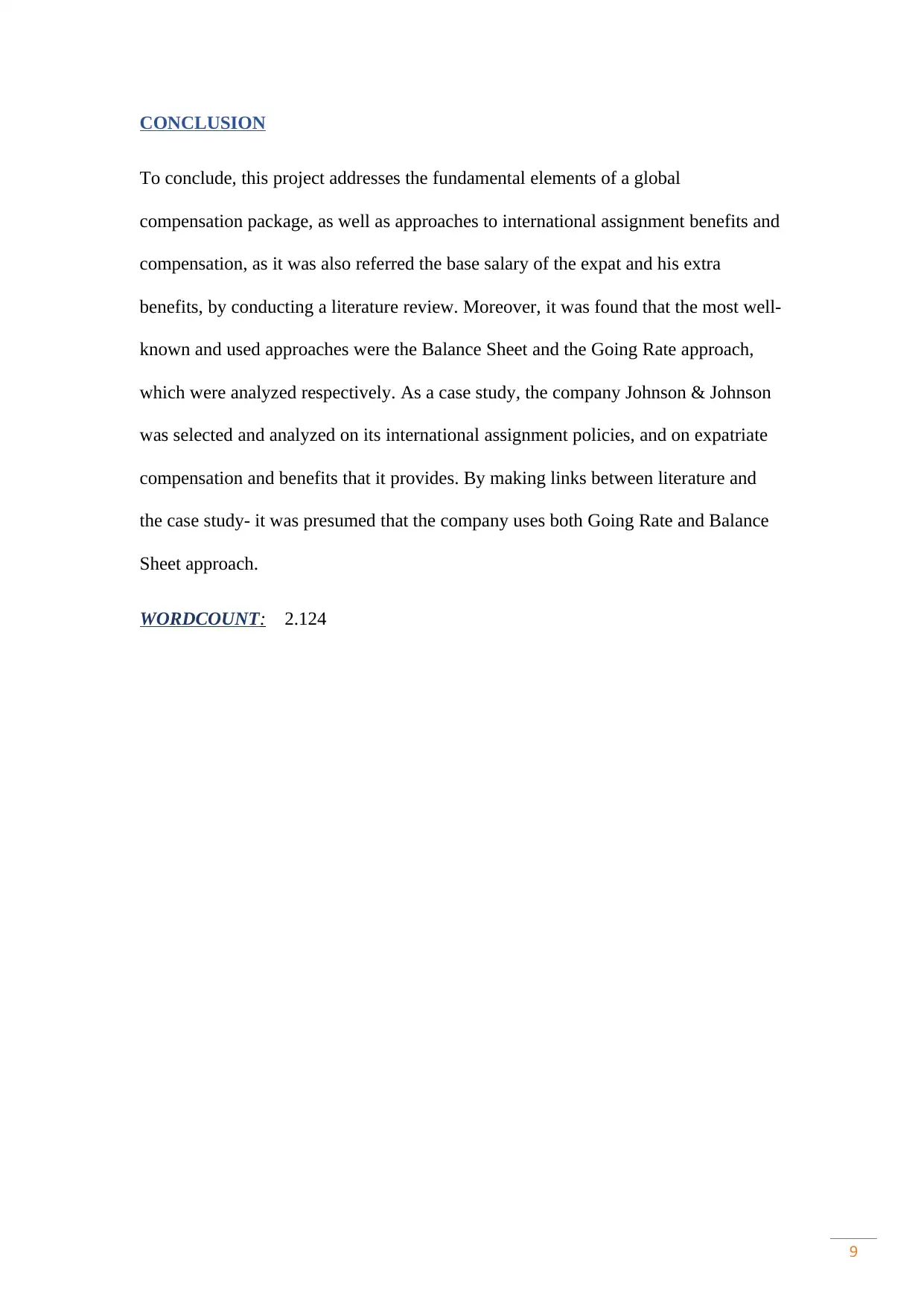
9
CONCLUSION
To conclude, this project addresses the fundamental elements of a global
compensation package, as well as approaches to international assignment benefits and
compensation, as it was also referred the base salary of the expat and his extra
benefits, by conducting a literature review. Moreover, it was found that the most well-
known and used approaches were the Balance Sheet and the Going Rate approach,
which were analyzed respectively. As a case study, the company Johnson & Johnson
was selected and analyzed on its international assignment policies, and on expatriate
compensation and benefits that it provides. By making links between literature and
the case study- it was presumed that the company uses both Going Rate and Balance
Sheet approach.
WORDCOUNT: 2.124
CONCLUSION
To conclude, this project addresses the fundamental elements of a global
compensation package, as well as approaches to international assignment benefits and
compensation, as it was also referred the base salary of the expat and his extra
benefits, by conducting a literature review. Moreover, it was found that the most well-
known and used approaches were the Balance Sheet and the Going Rate approach,
which were analyzed respectively. As a case study, the company Johnson & Johnson
was selected and analyzed on its international assignment policies, and on expatriate
compensation and benefits that it provides. By making links between literature and
the case study- it was presumed that the company uses both Going Rate and Balance
Sheet approach.
WORDCOUNT: 2.124
Paraphrase This Document
Need a fresh take? Get an instant paraphrase of this document with our AI Paraphraser
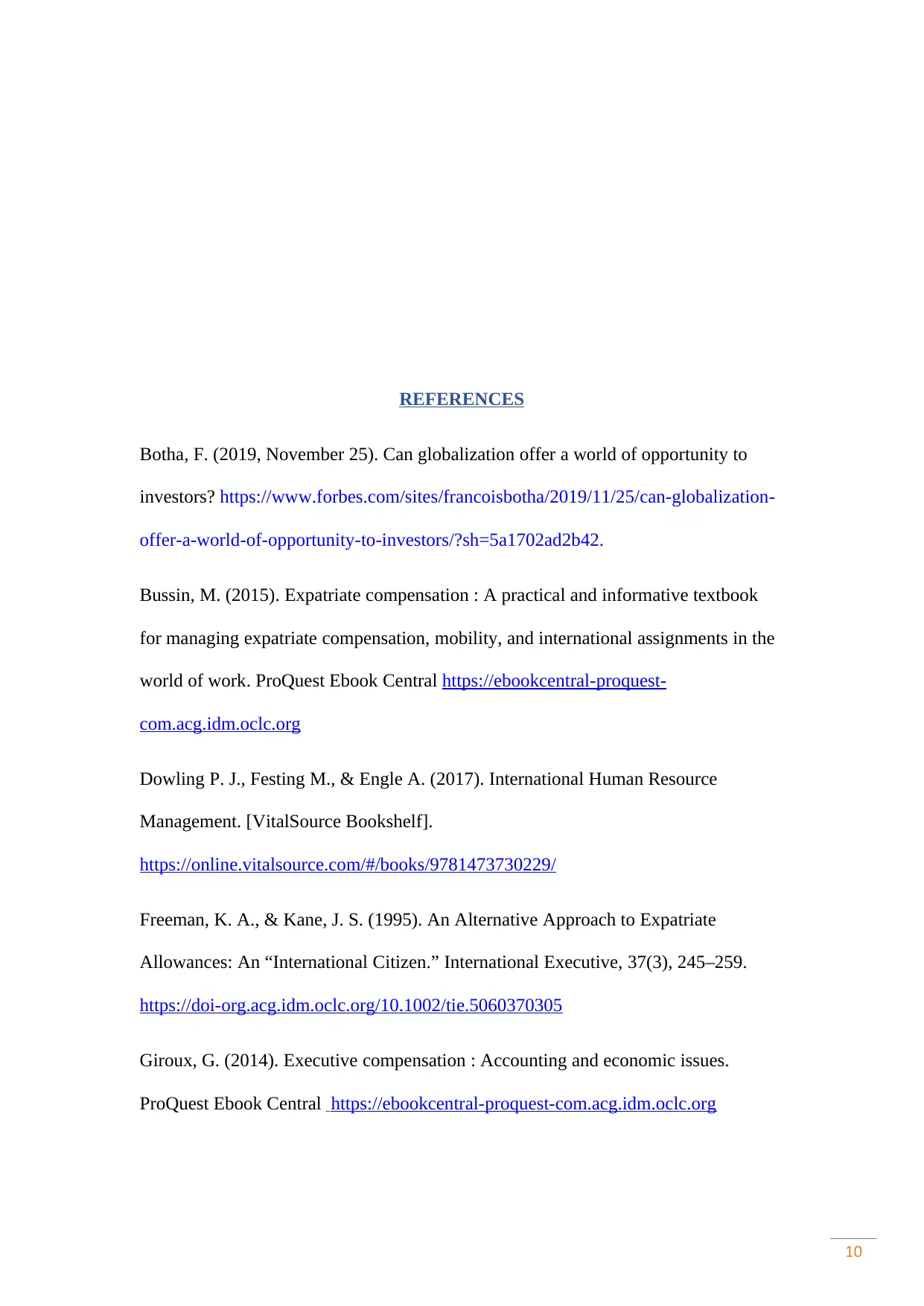
10
REFERENCES
Botha, F. (2019, November 25). Can globalization offer a world of opportunity to
investors? https://www.forbes.com/sites/francoisbotha/2019/11/25/can-globalization-
offer-a-world-of-opportunity-to-investors/?sh=5a1702ad2b42.
Bussin, M. (2015). Expatriate compensation : A practical and informative textbook
for managing expatriate compensation, mobility, and international assignments in the
world of work. ProQuest Ebook Central https://ebookcentral-proquest-
com.acg.idm.oclc.org
Dowling P. J., Festing M., & Engle A. (2017). International Human Resource
Management. [VitalSource Bookshelf].
https://online.vitalsource.com/#/books/9781473730229/
Freeman, K. A., & Kane, J. S. (1995). An Alternative Approach to Expatriate
Allowances: An “International Citizen.” International Executive, 37(3), 245–259.
https://doi-org.acg.idm.oclc.org/10.1002/tie.5060370305
Giroux, G. (2014). Executive compensation : Accounting and economic issues.
ProQuest Ebook Central https://ebookcentral-proquest-com.acg.idm.oclc.org
REFERENCES
Botha, F. (2019, November 25). Can globalization offer a world of opportunity to
investors? https://www.forbes.com/sites/francoisbotha/2019/11/25/can-globalization-
offer-a-world-of-opportunity-to-investors/?sh=5a1702ad2b42.
Bussin, M. (2015). Expatriate compensation : A practical and informative textbook
for managing expatriate compensation, mobility, and international assignments in the
world of work. ProQuest Ebook Central https://ebookcentral-proquest-
com.acg.idm.oclc.org
Dowling P. J., Festing M., & Engle A. (2017). International Human Resource
Management. [VitalSource Bookshelf].
https://online.vitalsource.com/#/books/9781473730229/
Freeman, K. A., & Kane, J. S. (1995). An Alternative Approach to Expatriate
Allowances: An “International Citizen.” International Executive, 37(3), 245–259.
https://doi-org.acg.idm.oclc.org/10.1002/tie.5060370305
Giroux, G. (2014). Executive compensation : Accounting and economic issues.
ProQuest Ebook Central https://ebookcentral-proquest-com.acg.idm.oclc.org
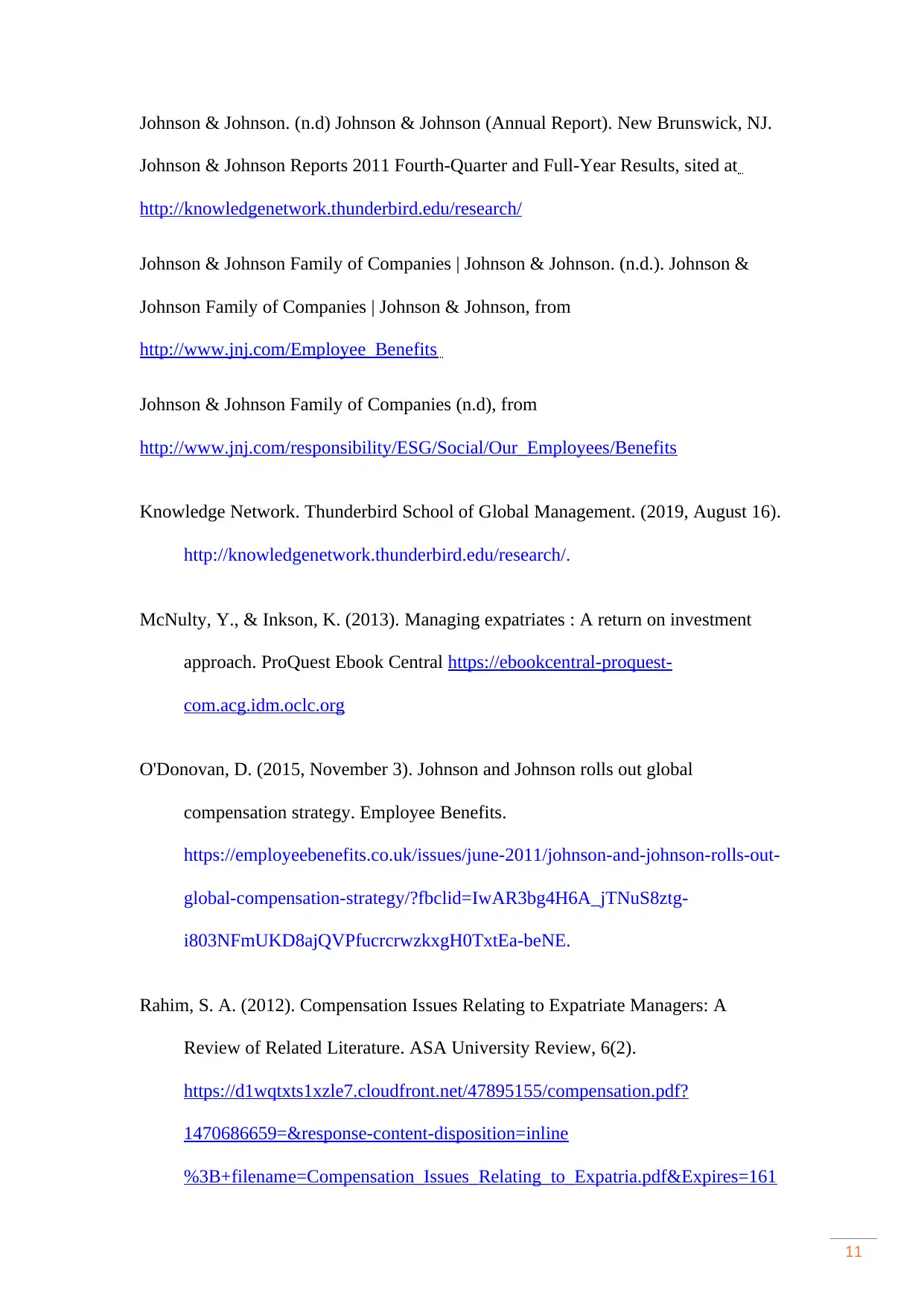
11
Johnson & Johnson. (n.d) Johnson & Johnson (Annual Report). New Brunswick, NJ.
Johnson & Johnson Reports 2011 Fourth-Quarter and Full-Year Results, sited at
http://knowledgenetwork.thunderbird.edu/research/
Johnson & Johnson Family of Companies | Johnson & Johnson. (n.d.). Johnson &
Johnson Family of Companies | Johnson & Johnson, from
http://www.jnj.com/Employee_Benefits
Johnson & Johnson Family of Companies (n.d), from
http://www.jnj.com/responsibility/ESG/Social/Our_Employees/Benefits
Knowledge Network. Thunderbird School of Global Management. (2019, August 16).
http://knowledgenetwork.thunderbird.edu/research/.
McNulty, Y., & Inkson, K. (2013). Managing expatriates : A return on investment
approach. ProQuest Ebook Central https://ebookcentral-proquest-
com.acg.idm.oclc.org
O'Donovan, D. (2015, November 3). Johnson and Johnson rolls out global
compensation strategy. Employee Benefits.
https://employeebenefits.co.uk/issues/june-2011/johnson-and-johnson-rolls-out-
global-compensation-strategy/?fbclid=IwAR3bg4H6A_jTNuS8ztg-
i803NFmUKD8ajQVPfucrcrwzkxgH0TxtEa-beNE.
Rahim, S. A. (2012). Compensation Issues Relating to Expatriate Managers: A
Review of Related Literature. ASA University Review, 6(2).
https://d1wqtxts1xzle7.cloudfront.net/47895155/compensation.pdf?
1470686659=&response-content-disposition=inline
%3B+filename=Compensation_Issues_Relating_to_Expatria.pdf&Expires=161
Johnson & Johnson. (n.d) Johnson & Johnson (Annual Report). New Brunswick, NJ.
Johnson & Johnson Reports 2011 Fourth-Quarter and Full-Year Results, sited at
http://knowledgenetwork.thunderbird.edu/research/
Johnson & Johnson Family of Companies | Johnson & Johnson. (n.d.). Johnson &
Johnson Family of Companies | Johnson & Johnson, from
http://www.jnj.com/Employee_Benefits
Johnson & Johnson Family of Companies (n.d), from
http://www.jnj.com/responsibility/ESG/Social/Our_Employees/Benefits
Knowledge Network. Thunderbird School of Global Management. (2019, August 16).
http://knowledgenetwork.thunderbird.edu/research/.
McNulty, Y., & Inkson, K. (2013). Managing expatriates : A return on investment
approach. ProQuest Ebook Central https://ebookcentral-proquest-
com.acg.idm.oclc.org
O'Donovan, D. (2015, November 3). Johnson and Johnson rolls out global
compensation strategy. Employee Benefits.
https://employeebenefits.co.uk/issues/june-2011/johnson-and-johnson-rolls-out-
global-compensation-strategy/?fbclid=IwAR3bg4H6A_jTNuS8ztg-
i803NFmUKD8ajQVPfucrcrwzkxgH0TxtEa-beNE.
Rahim, S. A. (2012). Compensation Issues Relating to Expatriate Managers: A
Review of Related Literature. ASA University Review, 6(2).
https://d1wqtxts1xzle7.cloudfront.net/47895155/compensation.pdf?
1470686659=&response-content-disposition=inline
%3B+filename=Compensation_Issues_Relating_to_Expatria.pdf&Expires=161
⊘ This is a preview!⊘
Do you want full access?
Subscribe today to unlock all pages.

Trusted by 1+ million students worldwide
1 out of 14
Related Documents
Your All-in-One AI-Powered Toolkit for Academic Success.
+13062052269
info@desklib.com
Available 24*7 on WhatsApp / Email
![[object Object]](/_next/static/media/star-bottom.7253800d.svg)
Unlock your academic potential
Copyright © 2020–2025 A2Z Services. All Rights Reserved. Developed and managed by ZUCOL.



